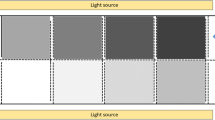Abstract
Photosynthesis and growth in low light and survival under simulated winter conditions were studied in the freefloating green alga Ulva lactuca L., collected in Roskilde Fjord, Denmark during late autumn and maintained in stock in natural water. It adapts efficiently to low light by increasing chlorophyll concentration and light absorption and continues to grow at the lowest irradiance tested, 0.6 μE m-2 s-1. This irradiance corresponds to minimum light requirements of deep-living marine macroalgae and phytoplankton growing under ice. The photosynthetic efficiency per unit of incident light is five-fold higher for U. lactuca grown at 1.7 μE PAR m-2 s-1 as compared with 56.3 μE m-2 s-1, and the efficiency per unit of light absorbed is twice as high. The maximum photosynthetic efficiency (0.051 mol C E-1 absorbed) is similar to values for shade-adapted marine phytoplankton. U. lactuca is able to survive for two months in the dark and to resume growth immediately when transferred to light. Exposure to anoxia and sulphide gradually reduces vitality, but does not affect survival over two months. Rigorous deep freezing is detrimental to survival of U. lactuca, while field samples show that more gradual, natural freezing is not. U. lactuca is not easily fitted into one of the traditional strategy concepts. U. lactuca is a very plastic species that combines rapid growth during favourable periods (“opportunism”) with high survival capacity in the same type of tissue during stress periods (“persistence”). U. lactuca occupies a niche as a free-floating form in sedimentary coastal areas that are devoid of attached algae.
Similar content being viewed by others
Literature cited
Bannister, T. T.: Production equations in terms of chorophyll concentration, quantum yield, and upper limit to production. Limnol. Oceanogr. 19, 1–12 (1974)
Bannister, T. T. and A. D. Weidemann: The maximum quantum yield of phytoplankton photosynthesis in situ. J. Plankt. Res. 6, 275–294 (1985)
Beer, S. and A. Eshel: Photosynthesis of Ulva sp. I: Effects of desiccation when exposed to air. J. exp. mar. Biol. Ecol. 70, 91–97 (1983)
Borum, J.: Development of epiphytic communities on eelgrass (Zostera marina) along a nutrient gradient in a Danish estuary. Mar. Biol. 87, 233–241 (1985)
Falkowski, P. G., Z. Dubinsky and K. Wyman: Growth-irradiance relationships in phytoplankton. Limnol. Oceanogr. 30, 311–321 (1985)
King, R. J. and W. Schramm: Photosynthetic rates of benthic marine algae in relation to light intensity and seasonal variations. Mar. Biol. 37, 215–222 (1976)
Kirk, J. T. O.: Light and photosynthesis in aquatic ecosystems, 401 pp. Cambridge: Cambridge University Press 1983
Lapointe, B. E. and K. R. Tenore: Experimental outdoor studies with Ulva fasciata Delile. I: Interactions of light and nitrogen on nutrient uptake, growth and biochemical composition. J. exp. mar. Biol. Ecol. 53, 135–152 (1981)
Littler, M. M., and D. S. Littler: The evolution of thallus form and survival strategies in benthic marine macroalgae: field and laboratory tests of a functional form model. Am. Nat. 116, 25–44 (1980)
Lüning, K.: Light, Ch. 9. In: The biology of seaweeds, pp 326–355. Ed. by C. S. Lobban and M. J. Wynne. Botanical monographs, Vol. 17. Oxford: Blackwell 1981
Mishkind, M. and D. Mauzerall: Kinetic evidence for a common photosynthetic step in diverse seaweeds Mar. Biol. 58, 89–96 (1980)
Morgan, K. and J. Kalff: The winter dark survival of an algal flagellate Cryptomonas erosa (Skuja). Verh. int. Ver. Limnol. 19, 2734–2740 (1975)
Pianka, E. R.: On r- and k-selection. Am. Nat. 104, 592–597 (1970)
Ramus, J.: Seaweed anatomy and photosynthetic performance: the ecological significance of light guides, heterogenous absorption and multiple scatter. J. Phycol. 14, 352–362 (1978)
Rosenberg, G. and J. Ramus: Uptake of inorganic nitrogen and seaweed surface area: volume ratios. Aquat. Bot. 19, 65–72 (1984)
Sand-Jensen, K. and D. H. Gordon: Differential ability of marine and freshwater macrophytes to utilize HCO -3 and CO2. Mar. Biol. 80, 247–253 (1984)
Steffensen, D. A.: The effect of nutrient enrichment and temperature on the growth in culture of Ulva lactuca L. Aquat. Bot. 2, 337–351 (1976)
Wintermans, J. F. G. M. and A. De Mots: Spectrophotometric characteristics of chlorophylls a and b and their pheophytins in ethanol Biochem. biophys. Acta 109, 448–453 (1965)
Zar, J. H.: Biostatistical analysis, 608 pp. Englewood Cliffs, NJ: Prentice Hall 1974
Author information
Authors and Affiliations
Additional information
Communicated by T. Fenchel, Aarhus
Rights and permissions
About this article
Cite this article
Vermaat, J.E., Sand-Jensen, K. Survival, metabolism and growth of Ulva lactuca under winter conditions: a laboratory study of bottlenecks in the life cycle. Mar. Biol. 95, 55–61 (1987). https://doi.org/10.1007/BF00447485
Accepted:
Issue Date:
DOI: https://doi.org/10.1007/BF00447485




